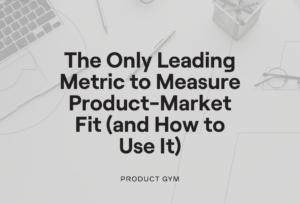“What would you say is the difference between UX and product design?” This is one of the trickiest product design interview questions to answer as a Product Manager. The two functions overlap frequently and Product Managers collaborate often with UX Designers — hence the confusion between UX Design vs Product Design.
Lucky for you, we have formulated a way for you to answer this question in the best way. Your response should have three parts:
- Part one: The set-up — how to introduce your answer.
- Part two: The examples —different illustrations you can give your interviewer.
- Part three: The follow-up — how to re-engage your interviewer after providing them with examples.
Why this structure? Our members using the template have consistently seen great success. We’ll also analyze some job descriptions and trends that support it.
Let’s get into it and get you this Product Manager job.
What’s the Difference Between UX Design and Product Design?
While we don’t advocate depending only on one framework for Product Manager interview questions and answers, they can help you provide the groundwork for your response. Here’s the template we’ve found works best with this product design question and a breakdown of why we decided to take this approach.
Part 1: The Set-Up
It’s funny that you asked me this question because I have a lot of friends that are UX designers and product designers, and the arguments that they get into sometimes about this topic can get heated.
I have read that they are two different roles, but the reality is there is a lot of overlap and organizations are increasingly mixing the two roles. Let me explain.
Setting up your answer this way instead of going straight into answer mode is great because it adds a bit of humor to the conversation. Having talked to many candidates already, interviewers are easily bored by interviews that take place like interrogations. Keeping it light with conversations like these makes your session more engaging and memorable.
At the same time, this setup is a way to establish common ground with your interviewer. You’re most likely going to have this conversation with somebody in the industry and the more they feel like they can relate to your answer, the better the rapport you will create. The rest of your answer will be better received if the interviewer feels like you are part of the tribe.
Part 2: Examples
Now is the time to prove that you have a concrete understanding of what you are talking about.
Let’s start with what UX design vs product design have in common.
Example one:
“So both UX design and product design adhere to the same design thinking principles of define, discover, ideate, validate and all that other good stuff, right?”
Now I’ve heard product designers say UX designers focus on the needs of the users, while product designers need to focus on the needs of the user and the business. But, I have many UX designer friends who argue that they do that too.
Any time you have positives and negatives — in this case, similarities and differences — it’s always best to start with the similarities to keep the positivity going after your setup. Presenting your answer like this also shows that you are knowledgeable on the subject and so does using industry lingo.
Notice also that the answer is presented as a general sentiment. You never want to take a side or present something as your own opinion, so play the role of a politician by avoiding phrases like, “in my opinion”, “this is what I think/feel”, or “what I know to be true”. Taking a solid stand is risky because your interviewer may hold a different opinion and will “fail” you immediately.
Example two:
I have also heard UX designers say they spend most of their time developing products before launch, while product designers spend most of their time updating products that have already been launched.
I came across a blog that said the difference in UX design vs product design is not what they do, they do the exact same thing, but the difference is when.
Giving the interviewer a second example presents a comparison that shows you have a good deal of knowledge on the subject.
Part Three: The Follow-Up
How does your team differentiate between UX and product design?
A lot of companies don’t have a product design position. They usually have UX designers doing product design work. This is why their definition of a product designer is the most important — it will give you clarity on the job description and the company’s product design process. Not forgetting that throwing it back to your interviewer is an opportunity for you to engage them in a conversation.
The most important thing to remember is you never want to give an absolute answer. There’s a lot of gray area in product management and the more that you can communicate effectively on what that gray area is, the more knowledgeable you will come across.
What’s the Difference Between UX and Product Design? Our Response Explained
Why do we recommend giving this type of answer to product design questions like these? It all has to do with the background of UX and product design.
The title UX Designer grew in popularity with the changes technology caused to design from 2013 to 2017. Before that UX Designers were referred to as interaction designers, usability analysts, or usability researchers.
The title then evolved into Product Designer onwards of 2017, and it became more mainstream as demand for Product Managers grew. Theoretically speaking, UX design and product design are two separate functions, however, companies often use the two terms interchangeably.
Product Designer vs UX Designer Job Posting Examples
For example, here’s the job description for a Spotify Product Designer position on our jobs board:
- Lead design projects across the entire product lifecycle and multiple product launches.
- Set the vision for the user experience and build the space for others to collaborate.
- Work with small multi-disciplinary teams and partner closely with engineering, product, marketing, and business stakeholders to find elegant but practical solutions to design challenges.
- Provide design thinking and leadership to develop the right product strategy. You’ll collaborate to tackle problems and come up with solutions that delight our users.
- Be autonomous, You’ll take full ownership of your work, and take responsibility for every last detail, every step of the way.
- Rapidly produce multiple concepts and prototypes, and know-how and when to create and combine flows, user stories, sketches, wireframes, and deliver pixel-perfect specs.
Another Etsy Product Designer job description reads:
- Discovering insights, opportunities, and requirements.
- Testing prototypes and hypotheses with users to collect feedback.
- Launching experiments and evaluating how they perform and to iterate.
- Presenting your work to peers and leadership, async and in-person.
- Taking part in weekly design critiques, workshops, all hands, and squad meetings
- Thinking and writing about your process and documenting your decisions.
Both of these job descriptions outline roles and responsibilities that most UX designers are qualified for. So essentially, UX designers can apply for product designer jobs and vice versa. The difference? There was a time when UX was a hot acronym and now product is the hot term.
Still confused? Watch our co-founder Rich Chen break it down in the video below on how to answer the interview question on UX design vs product design:
Ace Your Product Design Interview Questions
Hopefully, the information we’ve given you will help you answer this question confidently. Remember that product design questions are just as important as technical, product metrics, product strategy, roadmap, and behavioral interview questions.
Need more help with product design interview questions and answers? Schedule a free call with our in-house team of PM recruiter experts and we’ll even send you a PDF of all the other product design interview questions that you’re most likely going to receive during a PM interview.



